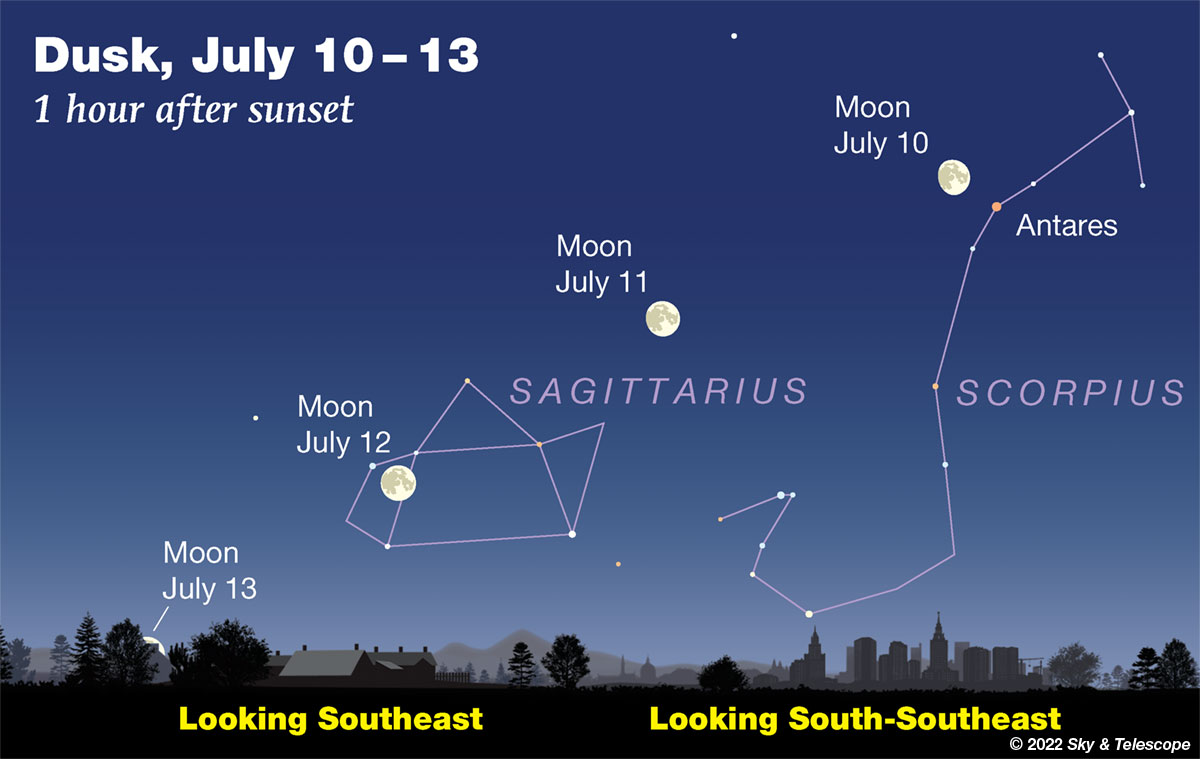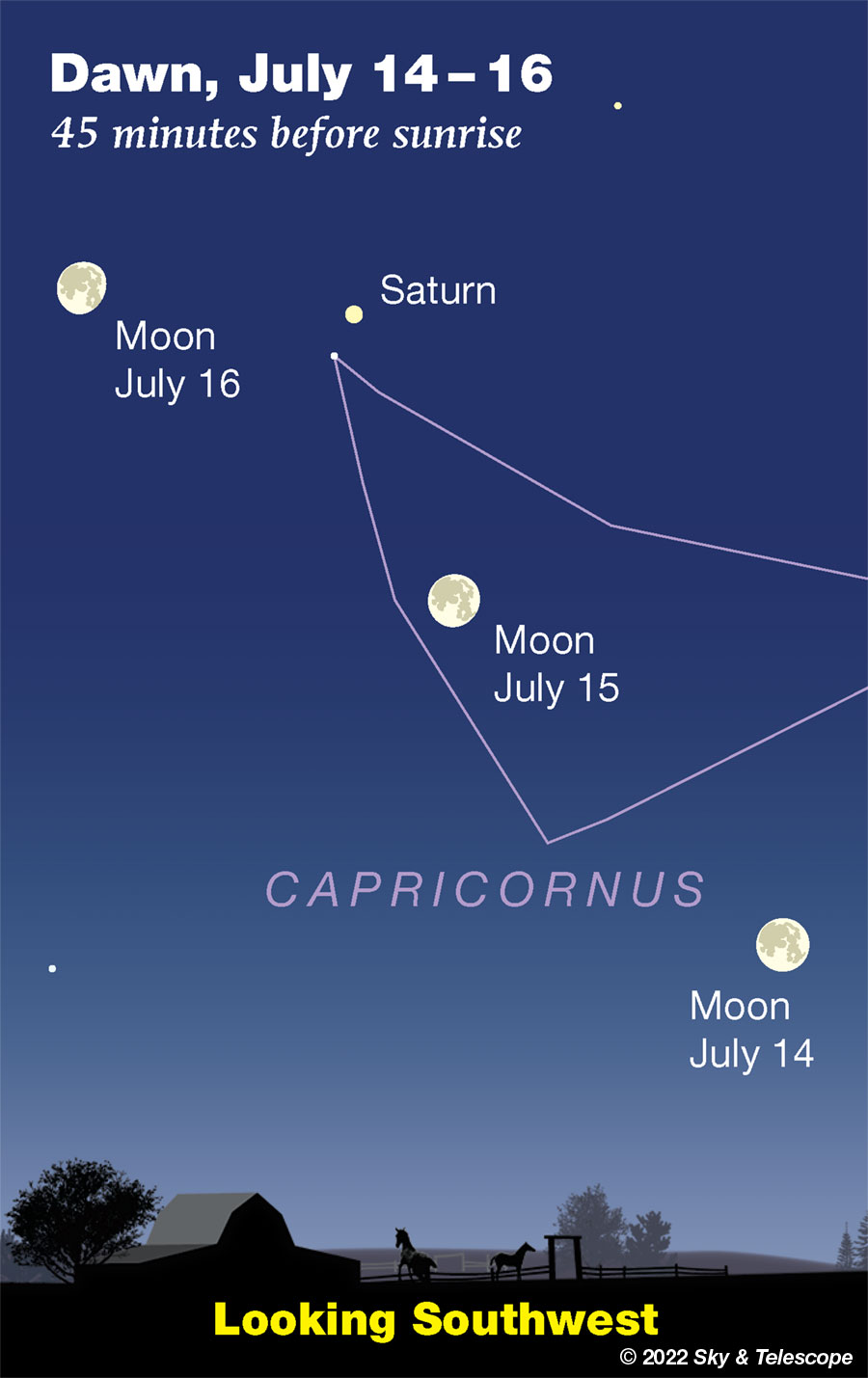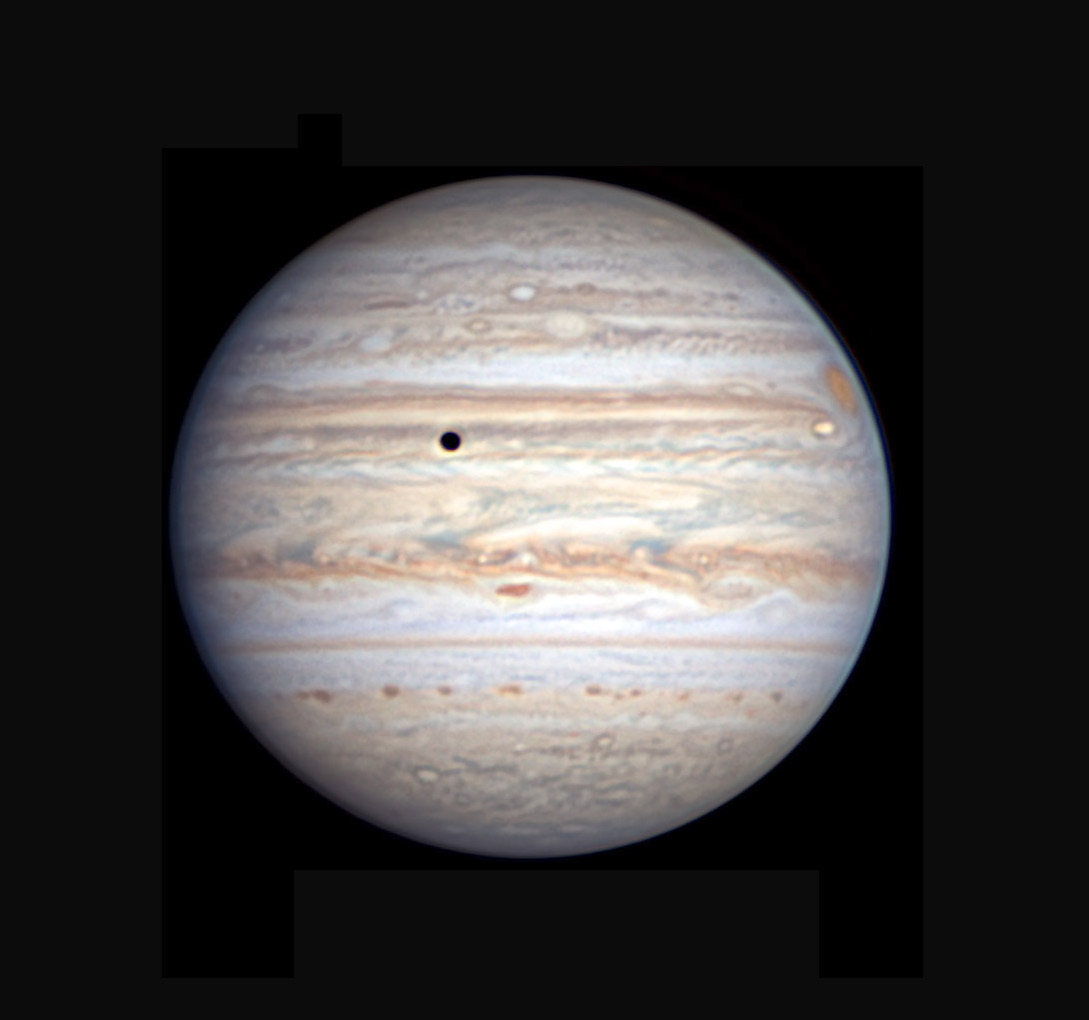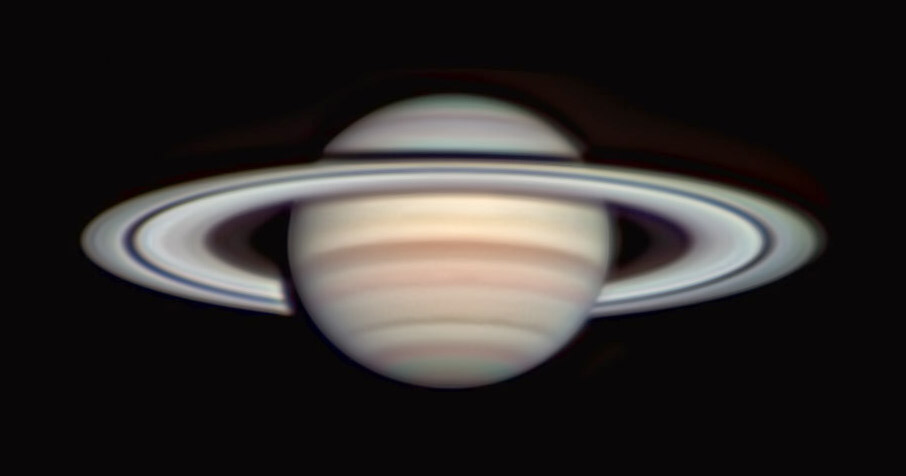FRIDAY, JULY 8
■ Titan and its atmosphere will occult a star! David Dunham of the International Occultation Timing Association writes, "Titan, the 8th-magnitude moon of Saturn with a thick atmosphere, will occult a star of the same brightness on Saturday morning, July 9. The occultation will be visible from much of North America: south of the northern limit that crosses central California, the southeast corner of Idaho, and north of Winnipeg, Manitoba. The southern limit crosses northwestern South America. Titan will be 3 arcminutes east of Saturn [about 4 ring-diameters].
"The occultation will last up to 5.5 minutes, shorter especially near the limits. When Titan gets close enough to the star that the two appear to merge, they will appear as a single object of magnitude 7.9. Then, for several seconds, the object will gradually diminish in brightness as the star sinks into Titan’s atmosphere, eventually reaching the magnitude 8.5 of Titan alone as the star completely disappears. The merged objects will similarly brighten when the star reappears."
That decline of 0.6 magnitude will difficult to track by eye, "but can be recorded well with a sensitive video or CCD camera." Such recordings "will be able to measure Titan’s atmosphere at a unique latitude of the moon, possibly recording brightening spikes caused by inversion layers in the atmosphere, as have been recorded during many previous occultations by planets and satellites with atmospheres.
"Of special interest may be the central flash that will occur close to the occultation’s central line, when Titan’s entire [ipper] atmosphere will focus the star’s light, causing it to brighten briefly well above its un-occulted level at central occultation."
Maps, a timetable for hundreds of locations, and more information are on IOTA's webpage for this event (updated).
"The next observable occultation of a similarly bright star by Titan won’t occur until 2048," writes Dunham, "and that will only be visible from Antarctica, so you are encouraged to make what observations you can of this rare event."
See also Bob King's Titan Occults a Bright Star (he calls magnitude 8.8 "bright"). The article has a map of the eyepiece field including Saturn's other moons, and also a video recording of Titan occulting a much brighter star (through poor seeing) in 1989. It shows several events caused by Titan's atmospheric strata during the star's entry and exit, and also a central flash.
SATURDAY, JULY 9
■ To the left of the waxing gibbous Moon, look for orange Antares and the rest of the stars of upper Scorpius.
■ The Big Dipper, high in the northwest after dark, is turning around to "scoop up water" through the evenings of summer and early fall.
SUNDAY, JULY 10
■ Now the moon shines only about 2° from Antares, as shown below. Look for Antares to the Moon's lower right.

MONDAY, JULY 11
■ Face east after nightfall and look way high. The brightest star there is Vega. Look lower left of it, by two or three fists at arm's length, for Deneb, the brightest of Cygnus the Swan.
Far down below Deneb, the Great Square of Pegasus is coming up from behind the horizon. At the very end of twilight only half of it is up yet, depending on your latitude. Give it another hour and all four of its stars will be over the horizon (again, depending on your latitude). The Great Square — or "Great Diamond" in its current orientation — is about 15° on a side.
TUESDAY, JULY 12
■ The Moon shines in or near the handle of the Sagittarius Teapot tonight. The handle is about 4° tall, so its four stars fit within the view of nearly all binoculars. Its brightest star is Nunki, the one on the upper left: magnitude 2.o.
■ Cassiopeia is now well past its bottoming-out for the year even when seen right after dark. Look for its tilted W pattern low-ish in the north-northeast. The farther north you live, the higher it will be. Cas will climb higher in the coming hours and in the coming months.
WEDNESDAY JULY 13
■ Full Moon (exact at 2:38 p.m. EDT). The Moon rises around sunset. By dark it's up in the southeast, between Sagittarius and Capricornus.
■ Arcturus and Vega are about equally far from the zenith in late twilight as the stars come out: Arcturus toward the southwest, Vega toward the east.
Once it's dark, draw a line from Arcturus to Vega. A third of the way along the line is dim, semicircular Corona Borealis with its one moderately bright star, Alphecca.
Two thirds of the way along the line is the dim Keystone of Hercules.

THURSDAY, JULY 14
■ July is Scorpius month; the twisty constellation shines highest in the south after dark these evenings. Its brightest star is orange Antares. Other, whiter stars of Scorpius's upper part are around Antares and to its upper right. The rest of Scorpius runs down and then left.
Three stars to Antares's right form a roughly vertical line: they mark the head, or forehead, of the Scorpion. Counting down, they are Beta, Delta, and fainter Pi Scorpii.
Delta Sco, the middle one, is the brightest of the three. It's an irregular variable star, a fast-rotating blue subgiant throwing off luminous gas from its equator. It also has a smaller orbiting companion that seems to trigger activity at 10.5-year intervals. Assumed for centuries to be stable, Delta unexpectedly doubled in brightness in July 2000 and has remained nearly that bright, with fluctuations, for many of the years since. Astronomers are waiting to see whether it will show new activity any time now, as the companion makes its third pass by the primary star since 2000.
Delta Sco is currently about magnitude 1.9, pretty much where it has stayed for the last 11 years.
FRIDAY, JULY 15
■ The waning gibbous Moon rises around 10 p.m. daylight saving time, with Saturn above it. They rise higher through the night and shine highest in the south before dawn on the 16th, with Saturn now to the Moon's right.
SATURDAY, JULY 16
■ With the advance of summer, the Sagittarius Teapot sits in the south-southeast after dark now. It's about the apparent size of your fist at arm's length. The Teapot is just starting to tilt to the right as if to pour. The Teapot will tilt more and more for the rest of the summer — or for much of the night if you stay out late.
■ To the lower right of the Teapot, the tail of Scorpius is low due south right after dark. How low depends on how far north or south you live: the farther south, the higher.
Look for the two stars especially close together in the tail. These are Lambda and fainter Upsilon Scorpii, known as the Cat's Eyes. They're canted at an angle; the cat has a bleary eye and is tilting its head to the right. (Lambda is brighter than Upsilon; they're magnitudes 1.6 and 2.6.) Both are blue-white supergiants, 700 and 500 light years away, respectively. Yes, the fainter one is nearer.
Between the Cat's Eyes and the Teapot's spout are the open star clusters M6 and especially M7, showy in binoculars.
A line through the Cat's Eyes points west (right) by nearly a fist-width toward Mu Scorpii, a much tighter pair known as the Little Cat's Eyes. They're oriented almost exactly the same way as Lambda and Upsilon, but they're only 0.1° apart. These two are not a true binary: they're 800 and 500 light-years away, respectively. And yes, the fainter one is the nearer of this pair also.
■ In the early morning hours of the 17th, the waning Moon shines about midway between Jupiter and Saturn.
This Week's Planet Roundup
Mercury is out of sight in conjunction with the Sun.
Venus, magnitude –3.9, rises just as dawn begins. As dawn brightens, look for Venus low in the east-northeast. If the sky isn't too bright yet, try for Aldebaran to Venus's upper right by a fist at arm's length or a little more. And maybe even the Pleiades above Aldebaran.
Brighter Capella shines farther to Venus's upper left.
Mars, magnitude +0.4 in Aries, rises around 1 a.m. and hangs high in the east-southeast as dawn begins. It's about three fists lower left of bright Jupiter. Mars is still tiny in a telescope, 7½° arcseconds in diameter.
Jupiter, impressive at magnitude –2.5 (at the Pisces-Cetus border), rises due east around midnight. It's nearly at its highest in the south as dawn begins. It's already 43 arcseconds wide.

On this side of the planet, the South Equatorial Belt is currently divided into two thin dark lines. The North Equatorial Belt looks more turbulent than we've seen it recently, and it hosts a tiny white outbreak (cloud upsurge) near the central meridian, just above a dark red barge in the North Tropical Zone.
Saturn, magnitude +0.5 in western Capricornus, rises in the east-southeast in late twilight. It's highest in the south for best telescopic viewing in the hour or two before dawn. (Dawn begins about 2 hours before sunrise now.) Saturn's rings appear roughly as wide as Jupiter's disk.
The little star 1.4° below Saturn before dawn is Delta Capricorni, magnitude 2.8.

Uranus, magnitude 5.8 in Aries, is in the east before the first light of dawn (lower left of Mars.
Neptune, magnitude 7.9 at the Aquarius-Pisces border, is high in the southeast before the first light of dawn, right of Jupiter.
All descriptions that relate to your horizon — including the words up, down, right, and left — are written for the world's mid-northern latitudes. Descriptions and graphics that also depend on longitude (mainly Moon positions) are for North America.
Eastern Daylight Time, EDT, is Universal Time minus 4 hours. (Universal Time is also called UT, UTC, GMT or Z time.)
Want to become a better astronomer? Learn your way around the constellations. They're the key to locating everything fainter and deeper to hunt with binoculars or a telescope.
This is an outdoor nature hobby. For an easy-to-use constellation guide covering the whole evening sky, use the big monthly map in the center of each issue of Sky & Telescope, the essential magazine of astronomy.
Once you get a telescope, to put it to good use you'll need a detailed, large-scale sky atlas (set of charts). The basic standard is the Pocket Sky Atlas (in either the original or Jumbo Edition), which shows stars to magnitude 7.6.

Next up is the larger and deeper Sky Atlas 2000.0, plotting stars to magnitude 8.5; nearly three times as many. The next up, once you know your way around, are the even larger Interstellarum atlas (stars to magnitude 9.5) or Uranometria 2000.0 (stars to magnitude 9.75). And be sure to read How to Use a Star Chart with a Telescope. It applies just as much to charts on your phone or tablet as to charts on paper.
You'll also want a good deep-sky guidebook. A beloved old classic is the three-volume Burnham's Celestial Handbook. An impressive more modern one is the big Night Sky Observer's Guide set (2+ volumes) by Kepple and Sanner.
Can a computerized telescope replace charts? Not for beginners, I don't think, and not on mounts and tripods that are less than top-quality mechanically, meaning heavy and expensive. And as Terence Dickinson and Alan Dyer say in their Backyard Astronomer's Guide, "A full appreciation of the universe cannot come without developing the skills to find things in the sky and understanding how the sky works. This knowledge comes only by spending time under the stars with star maps in hand."
![]() Audio sky tour. Out under the evening sky with your
Audio sky tour. Out under the evening sky with your
earbuds in place, listen to Kelly Beatty's monthly
podcast tour of the heavens above. It's free.
"The dangers of not thinking clearly are much greater now than ever before. It's not that there's something new in our way of thinking, it's that credulous and confused thinking can be much more lethal in ways it was never before."
— Carl Sagan, 1996
"Facts are stubborn things."
— John Adams, 1770
 4
4









Comments
Rod
July 11, 2022 at 8:12 am
This morning near 0430 EDT, Mars, Jupiter, and Saturn along the ecliptic a lovely, and bright sight to see with naked eyes 🙂 If tomorrow morning is as clear and cool as today (temp near 15C), I will have to get out my trusty 90-mm refractor telescope and enjoy some views. Saturn transits my location near 0337 EDT. All three planets according to Stellarium and Starry Night, show good altitudes for viewing (35-45 degrees elevation) near 0430 EDT with sunrise near 0551 EDT.
You must be logged in to post a comment.
Rod
July 11, 2022 at 9:43 am
Well, this morning spaceweather.com reports a very active Sun 🙂 [Observed 0830-0910 EDT. "New sunspot AR3056 is crackling with M-class solar flares. Credit: SDO/AIA" "The active regions in Lasky's video are mostly new. They either appeared for the first time or ballooned in size from an existing spot over the weekend. One of them, sunspot AR3055, is truly awesome, stretching more than 100,000 km from end to end with more than a dozen dark cores. It is almost directly facing Earth, and poses a threat for strong flares." My note. Some enjoyable and excellent views of the active regions reported on the Sun today using TeleVue 32-mm plossl at 31x using glass, white light solar filter. Distinct and easy to see plage areas around AR3046, AR3051, and AR3056. Numerous small and large dark cores visible. AR3055 reported to be some 100,000 km in diameter or larger. Spaceweather.com reported, “ACTIVE SUN: Spoiler alert: Something on the sun is about to explode. "There is an incredible-looking sunspot crossing the center of the solar disk and a new large dark core has just appeared on the limb," reports Illinois astronomer Apollo Lasky, who photographed the seething starscape:" My note. Very accurate, AR3055 spread across near the center of the solar disk and a new, large sunspot region appearing on the solar limb too. I could easily see at 31x using glass, white solar filter. The Sun angular size this morning ~ 31.46 arcminute. True FOV in my eyepiece at 31x ~ 96 arcminute. Easy solar observing this morning and plenty of active regions on the Sun. Given the Sun's distance ~ 1.0165 AU and size reported for AR3055, this active region with small and large dark cores visible ~ 2.5 arcminute angular size on the Sun. Earth size on the Sun ~ 17 arcsecond or a bit larger than 0.2833 arcminute.]
You must be logged in to post a comment.
Rod
July 12, 2022 at 6:33 am
I was able to view Mars, Jupiter, and Saturn with my telescope this morning.
[Observed 0420-0520 EDT/0820-0920 UT. Sunrise 0552 EDT in Gemini. Moon set near 0407 EDT. Full Moon 13-July-2022 1838 UT. I used 90-mm refractor telescope with TeleVue 1.8x Barlow lens and TeleVue 14-mm Delos for 129x views of Mars, Jupiter, and Saturn this morning. At Saturn I could see Cassini division, some cloud bands, and Titan and Rhea moons. Jupiter many cloud bands including NEB and SEB, no filters used. In the mirror reverse view, Io and Ganymede on left side, Callisto farther away in angular separation on the right side of Jupiter. When I moved Jupiter out of the FOV, I could see several 9th-10th magnitude stars in the FOV near Callisto position in Cetus. Mars was distinct gibbous shape planet, about 85.23% illuminated. Mars ~ 7.6 arcsecond size now, a hint of surface detail showing. There was a magnitude 10.40 star visible near Mars too~ 4.5 arcminute angular separation according to Stellarium 0.22.2. Starry Night Pro Plus 8 shows as TYC633-893-1. SIMBAD portal reports mv + 10.41, stellar parallax 1.273 mas. This is 2562 LY, Mars ~ 1.237 AU. Near 0457 EDT, I noticed an equatorial satellite moving eastward near the ecliptic and below Jupiter's position in the sky. Given Mars magnitude near 0.37 or 0.39, I estimate 1st magnitude satellite visible. An enjoyable, early morning viewing Mars, Jupiter, and Saturn. Clear skies, temperature 19C.]
You must be logged in to post a comment.
mary beth
July 14, 2022 at 12:52 pm
Interesting reports Rod! Glad you have had such nice conditions this week. It’s been real hot and humid here and some nights have been really too cloudy to enjoy the stars. The moon was very beautiful last night, we were able to view it unobstructed for just a few minutes but well worth the time to wait! It was so deep yellow! Nice that the satellite photobombed or shall I say scopebombed your viewing of Jupiter. Clever mind to even think to ascertain the magnitude of the satellite.
Heading to spaceweather to see if there is any videos of the sun activity July 11.
Oh on a sidenote, Altair seem to be extra bright to me. I believe it was Thursday and Friday night last week. When it came over the house I thought I was back in March looking at Arcturus as it rose on the East. Normally I don’t get shocked by Altair but both of those nights it was so bright that it really astounded me! Probably just the right conditions but it was oddly enjoyable!
You must be logged in to post a comment.
You must be logged in to post a comment.